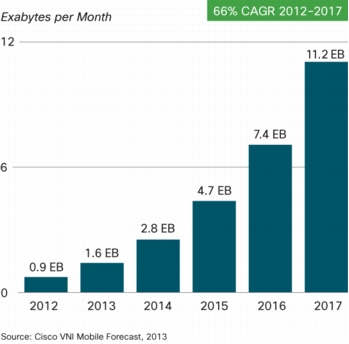Posts tagged mobile growth stats
12 Important Mobile Statistics from Mary Meeker’s Presentation
Jun 10th
 Former Morgan Stanley analyst Mary Meeker, who is now at venture capital firm Kleiner Perkins, often gives “state of the Web” presentations that are very popular and well known. She delivered a presentation yesterday, at the D10 conference, which is currently available on the web.
Former Morgan Stanley analyst Mary Meeker, who is now at venture capital firm Kleiner Perkins, often gives “state of the Web” presentations that are very popular and well known. She delivered a presentation yesterday, at the D10 conference, which is currently available on the web.
The presentation contains 112 slides and covers a variety of topics, including mobile stats, advertising, macroeconomic trends, “re-imagination”, and more.
Below we’ve detailed information about the 12 most captivating and helpful slides.
1. Statistics on 3G Growth and usage shown for 30 countries detailed how the fastest growth were in the following countries: Brazil, India and China. It suggests that emerging economies will move to 3G more quickly than developed economies.
2. The iPad is showing much faster growth than both the iPhone and iPod. The iPhone established apps, and the iPad is taking full advantage of this. As a result, Apple’s brand is much stronger than five years prior.
3. Android is proving more successful than the iPhone. This is partially due to the fact that it is a free service, and also because iPhone has helped establish the consumer smart phone market, paving the way for Android.
4. The smart phone market is really in its infancy. The growth of smart phone users from regular mobile users has only just begun to grow – it has leaps and bounds still to make.
5. Tablets, Readers and other hand-held devices are still growing, too. Currently, 29% of Americans own a tablet or reader, which is up by 2% from two years ago.
6. Mobile traffic now makes up 10% of all web traffic. This includes things like mobile email., apps, and more. The data was supplied by StatCounter. Mobile internet is projected to grow, which comes as no surprise.
7. Mobile web traffic has surpassed desktop web traffic in India, as of May 2012.
8. A small 8% of mobile commerce is made up of e-commerce in the United States.
9. Most of the money for mobile developers comes from app sales and not advertising. However. Both are growing rapidly. Currently Mobile Monetization is at 71% apps, and 29% ads.
10. Mobile advertising spending has a way to go before it is able to catch up with mobile time spent. Internet has a ways to go as well. Print spend is currently outweighing the amount of time spent reading.
11. Currently, ad rates are considerably lower on mobile web. For desktop internet they are at #3.50, while on mobile internet they are at $0.75.
12. The United States is at the technological center of the smart phone revolution, with a 64% share – up from 5% five years ago.
So what does it all mean? It all means that mobile is the way to go. The world is quickly evolving with the way they access and use the internet.
Source: Business Insider
(HTTP://www.businessinsider.com/the-12-most-important-slides-about-mobile-from-mary-meekers-presentation-2012-5?op=1#ixzz33clwmL1t)
Mobile Traffic Grew 70% In 2012
Feb 20th

Mobile usage trends continue ever upward, and the latest data and forecasts from Cisco are staggering.
Mobile traffic is increasing very quickly, growing 70% in 2012. What applications are eating up all that data? Not surprisingly, mobile video streaming apps account for the largest percentage of data use. Video is now more than half of mobile data traffic, with “information” at 12%, social networking at 7%, web browsing at 6%, and music streaming at only 4%. With large amounts of video content now available for free, and with apps like Netflix offering access to content treasure troves for a low monthly price, users are turning away from traditional video sources and moving onto their devices, especially tablets, which go anywhere and offer excellent on-demand functionality.
Correspondingly, each user is now consuming a lot more data, on average. Traffic per smartphone is up 80% in 2012, and Android users overtook iPhone users in terms of data consumed. The increase in usage can be attributed largely to advances in technology. Popular smartphones and tablets now offer faster download and processing speeds, as well as higher quality screens, that have made it tolerable to view streaming video and other content on a mobile device.
As far as provider structures, most of the data is now being consumed by users that have tiered plans. Unlimited plans, which once accounted for over 80% of data usage, are now less than 50%. This trend is a result of telecom providers’ need to constrain the top 1% of users, who consume staggering amounts of data. As mobile demand continues to grow, offload traffic (mobile devices connecting via Wi-Fi or other land-based networks) is expected to increase, and given the foregoing statistics, we can expect that it will be driven largely by users that do not want to exceed data caps.
These trends will lead to interesting results in the future.
By the end of 2013, there will be more devices on the planet than people (although, of course, this will not mean that everyone has a device). Looking further ahead, by 2017, two-thirds of mobile traffic is expected to be video, and mobile tablets will account for more traffic than the entire network did in 2012. As stated above, offload traffic will also continue to grow, and could be almost equivalent to all cell traffic by 2017! To keep pace with advancing technology, connection speeds on mobile devices will more than triple by that time, fueled mainly by growth in developing markets.
In short, mobile is expanding rapidly and shows no signs whatsoever of slowing down. Expect a highly mobile future.
